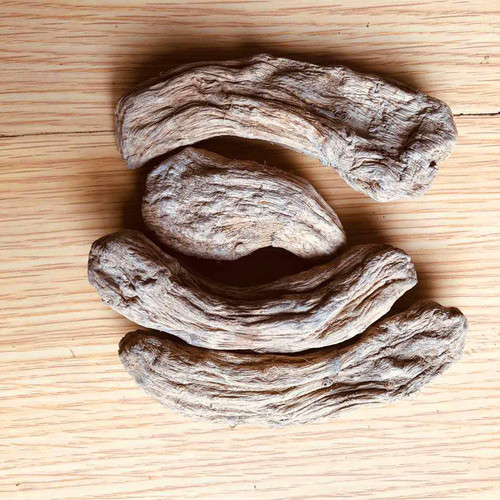Product Overview
Parts used: Dried ripe fruit
TCM category: Herbs that warm the Interior and/or expel Cold
TCM nature: Warm
TCM taste(s): Pungent
Meridian affinity: Spleen Stomach Kidney Liver
Scientific name: Illicium verum
Other names: Staranise, Star anise seed, Chinese star anise, Badiam, Badiane
Use of star anise (Ba Jiao Hui Xiang) in TCM
Please note that you should never self-prescribe TCM ingredients. A TCM ingredient is almost never eaten on its own but as part of a formula containing several ingredients that act together. Please consult a professional TCM practitionner, they will be best able to guide you.
Preparation: The fruit is picked when it is green or yellow, it is quickly plunged in boiling water and dried.
Dosage: 3-6g.
Main actions according to TCM*: Removes cold and warms Yang, regulates the flow of Qi so as to relieve pain, increase appetite.
Primary conditions or symptoms for which star anise may be prescribed by TCM doctors*: Abdominal colic Lumbago Vomiting Abdominal pain
Common TCM formulas in which star anise are used*:
For acute and chronic constipation caused by Heat in the Intestines combine star anise with aloe vera (Lu Hui).
Key TCM concepts behind star anise (Ba Jiao Hui Xiang)'s properties
In Traditional Chinese Medicine (TCM), star anise are plants that belong to the 'Herbs that warm the Interior and/or expel Cold' category. Herbs in this category are used for Internal Coldness with Qi and Yang Deficiency. In the Yin and Yang system of thought (see our explanation on Yin and Yang) Yang is Hot in nature. A deficiency of Yang will therefore lead to Internal Coldness since there will as a result be more Yin (Cold in nature) than Yang. In extreme cases this can lead to so-called 'Yang collapse' with convulsions or coma and these herbs are particularly indicated to treat such scenarios.
As suggested by its category star anise are plants that are Warm in nature. This means that star anise tend to help people who have too much "cold" in their body, although with less effect than a plant that would be Hot in nature. Balance between Yin and Yang is a key health concept in TCM. Those who have too much cold in their body are said to either have a Yin excess (because Yin is Cold in nature) or a Yang deficiency (Yang is Hot in Nature). Depending on your condition star anise can help restore a harmonious balance between Yin and Yang.
Star Anise also taste Pungent. The so-called "five elements" theory in Chinese Medicine states that the taste of TCM ingredients is a key determinant of their action in the body. Pungent ingredients like star anise tend to promote the circulations of Qi and body fluids. That's why for instance someone tends to sweat a lot when they eat spicy/pungent food.
The tastes of ingredients in TCM also determine what organs and meridians they target. As such star anise are thought to target the Spleen, the Stomach, the Kidney and the Liver. In TCM the Spleen assists with digestion, blood coagulation and fluid metabolism in the body. The Stomach on the other hand is responsible for receiving and ripening ingested food and fluids. It is also tasked with descending the digested elements downwards to the Small Intestine. The Kidneys do not only regulate the urinary system but also play a key role in the reproductive system and the growth and aging process of the body. The Liver is often referred as the body's "general" because it is in charge of regulating the movements of Qi and body fluids. It also takes a leading role in balancing our emotions.
Use of star anise (Ba Jiao Hui Xiang) as food
Star Anise are also eaten as food. It is used as an ingredient in dishes such as Masala chai, Five-spice powder or Pho.









